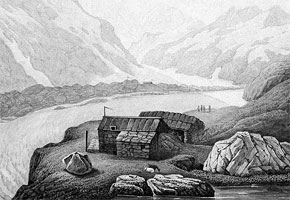

Brazil through the eyes of William James) covers the large volume of writing and drawings produced by the young James during the expedition
In 1865, an expedition led by Swiss natural scientist Louis Agassiz of Harvard University travelled around Brazil for 15 months to study the country.
In 1865, an expedition led by Swiss natural scientist Louis Agassiz of Harvard University travelled around Brazil for 15 months to study the country.

Brazil through the eyes of William James) covers the large volume of writing and drawings produced by the young James during the expedition
By Fábio de Castro
Agência FAPESP – In 1865, an expedition led by Swiss natural scientist Louis Agassiz (1807-1873) of Harvard University travelled around Brazil for 15 months to study the country. Among the voluntary collectors that participated in the expedition was a 23 year old medical student, William James (1842-1910), who would later become one of the most influential American thinkers, known mainly as one of the creators of pragmatic philosophy.
Organized by professor Maria Helena Toledo Machado of the History Department of Universidade de São Paulo’s (USP) Philosophy, Letters and Human Sciences School (FFLCH), the book Brazil through the eyes of William James covers the large volume of writing and drawings produced by the young James during the expedition. Unlike the travel logs typical of the period, the material left by James reveals a sensitive and empathetic traveler with unique perspectives on the nature and society of Brazil.
The book was launched on April 7 at the USP’s Maria Antônia University Center, during the opening of the exhibition Rastros e raças de Louis Agassiz: fotografia, corpo e ciência (Traces of Louis Agassiz: photography, body and science), a collection of a series of photographs obtained during the expedition on Brazilian racial types.
Launched originally in the United States in 2006 as a bi-lingual edition by Harvard University Press, the book is the result of a study initiated by Machado in 2003 at the Harvard libraries and archives, with funding from FAPESP under the Research Abroad Scholarships program.
The research continued in 2004 with institutional support of Harvard University’s David Rockefeller Center for Latin American Studies, through which the scientist participated as a Brazilian Visiting Fellow with the support of the Council for Scientific and Technological Development (CNPq). In 2006, the researcher obtained another fellowship from Harvard.
The book was well-received in U.S. academia, especially among specialists on William James’ works and those interested in philosophy, the history of scientific expeditions, race studies and science history.
“The documentation produced by James during his expeditions is notably original in relation to the array of travel diaries in the 19th century. While the majority of travelers take a distant, ethnocentric and paternalistic stance that presupposes the social insignificance of exotic countries, he is extremely empathetic and reflective,” explains the author to Agência FAPESP.
James’ perspective also significantly contrasts with the bias expressed by the expedition. Agassiz, founder of Harvard’s Museum of Comparative Zoology, intended to collect fish specimen and data on their geographic distribution in Brazil, with a view to contesting Charles Darwin’s theory of evolution, which he opposed.
During the trip – known as the Thayer Expedition because it was financed by magnate Nathaniel Thayer -, Agassiz became interested in studying the population, taking the initiative to document Brazilian racial types through photography with a view evaluating the results of miscegenation. The work is one of the main photographic registers of Brazil in the 19th century.
“Agassiz was a creationist and the scientific and racial focus of the expedition is a bit backwards. But this did not affect James’ perspective. Highly sensitive, he developed what I would characterize as empathy, which would be manifested throughout his work. He shows a great capacity to understand the world from the other’s perspective. Instead of the paternalistic and pious approach common among other travelers of the time, he got involved with people and managed to understand the profound differences of this unfamiliar society,” affirms Machado.
Miscegenation
According to the historian, the position James exhibited in his expedition diaries are reflected throughout the life of the thinker. Later, he would fight against imperialism, defend Darwinism, become a follower of relativism – which garnered much criticism – and would develop the notion of stream of consciousness.
“All these ideas are coherent to his manner of approaching reality, manifested during his time in Brazil. In hiswritings, he deconstructs the exotic perspective, the incomprehensible other, the foreigner alienated from the codes of local social life,” says Machado.
The researcher affirms that she now intends to work on cataloguing the complete collection of photos from Thayer Expedition to produce a book on Agassiz’s entire photography collection.
“The idea is to include all aspects of the expedition, but with a focus on the photography collection, which is significant. The issue of race ended up becoming the most important facet of the expedition and I want to start from the photography archive to investigate how this matter was viewed by Agassiz and how he viewed Brazil as the ideal place to study the supposed racial degeneration caused by miscegenation,” she says.
Brazil through the eyes of William James
Organizer: Maria Helena Toledo Machado
Launch: 2010
Price: R$ 60
Pages: 184
Republish
The Agency FAPESP licenses news via Creative Commons (CC-BY-NC-ND) so that they can be republished free of charge and in a simple way by other digital or printed vehicles. Agência FAPESP must be credited as the source of the content being republished and the name of the reporter (if any) must be attributed. Using the HMTL button below allows compliance with these rules, detailed in Digital Republishing Policy FAPESP.





